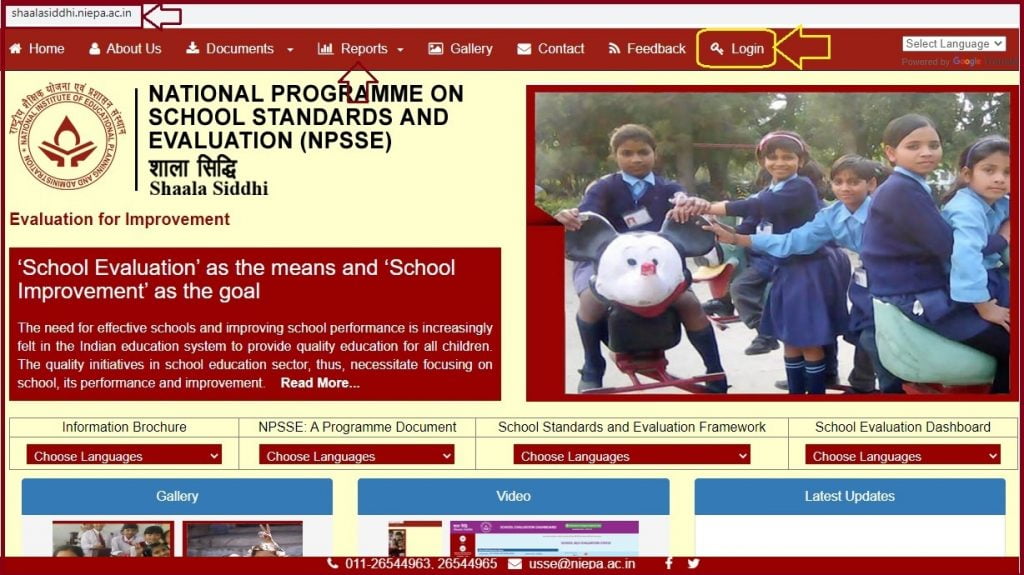The Shaala Siddhi Login, Registration, Data Entry at National Programme on School Standards and self Evaluation Portal. Shaala Siddhi Format 2025 PDF Download at https://shaalasiddhi.niepa.ac.in/Shaalasiddhi/Account/ShaalaSiddhiLogin
Shaala Siddhi
Quality education is a combination of a proper and effective education system. The Indian education department seeks to streamline and provide quality and improved education to all students in the country. The National Programme on School Standards and Evaluation NPSSE ensure the country’s education system is effective and in line with the student’s needs. The NPSSE offers comprehensive and inclusive school evaluation programmes to benefit all students.
National Programme on School Standards and Evaluation NPSSE are also referred to as shaala siddhi. It is a project developed to improve schools and education in India. The NPSSE is the creation of the National Institute of Education Planning and Administration NIEPA. The department is also supported by the Union Ministry of Human Resource Development.
Shaalasiddhi.niepa.ac.in
https://shaalasiddhi.niepa.ac.in/Shaalasiddhi/Account/ShaalaSiddhiLogin

The shaala siddhi programme works with elementary levels and Secondary schools. The sole aim is to improve education by providing quality facilities. The programme has established more than 1.62 million schools. The project will entail all education stakeholders to help tackle school developments issues. The NPSSE has introduced SSEF (School Standard and Evaluation Framework), a programme to help implement the school evaluation and improve performance. The SSEF helps in external and self-evaluation for stakeholders and schools.
The National Programme on School Standards and Evaluation NPSSE have established several features such as e-Samiksha (School Evaluation Dashboard e-Samiksha). The dashboard is designed for schools to provide evaluation details. The eligible participants in NPSSE (stakeholders and schools) should log in at the NPSSE website portal to provide all evaluation data. The details are categorized based on block, cluster, district, state, and national level.
NPSSE User Manual
The NPSSE develops the user manual to help all participating schools and stakeholders to access the online portal. Schools should fill the evaluation reports (self-evaluation) and upload them on the portal’s dashboard. The eligible participants need to register and log in using their credentials to access the user-manual page. First, the school should enter details on a hard copy and upload it on the NPSSE website portal.
How to Upload Self-Evaluation Details at Shaalasiddhi.niepa.ac.in
First, the authorized person or school should register on the portal.
- Visit the Shaala Siddhi web page using the link https://shaalasiddhi.niepa.ac.in/
- On the homepage, click the login button.
- For new users, click the option “New user” to continue.
- Enter the requested details:
- Select your level
- Enter UDISE code
- Applicant first name
- Last name
- Active mobile number and email ID.
- The system will send an OTP to the registered mobile number.
- Key in the OTP and click submit tab.
- Next, create a log-in password based on the page’s instructions.
- Now save the details and proceed to the login process.
Shaala Siddhi Login
The Shaala Siddhi Login step by step procedure
- Note the UDISE is your username (an 11-digit number).
- Next, enter the login password and click submit button.
Filling the Dashboard Details
The dashboard requires several information such as:
- Demographic profile
- The class attendance. The school should calculate the annual attendance using the formula offered on the web page.
- Once you arrive at the attendance rate, submit details.
- Next, enter the class learning outcome or performance in the percentage range. This applies to all classes; click submit to proceed.
- Enter the number of teachers in the schools and submit the details.
- On the teacher’s section, enter the teacher who has requested long leaves and short leaves.
- Submit to proceed to the next details.
- Now select your level based on the core standards and prioritize the areas of improvement as indicated on the page.
- Low
- Medium
- High
- Enter the seven key domains and mission statement (English only) using 20 to 50 words.
- Proceed and enter the area of improvement, proposed action, support required, and actions taken for the domains.
- Recheck the details and click submit button.
Submission and Data Unfreeze
- The applicant needs to read and agree to the term and conditions. Click the “I agree” check box on the page.
- Next, click the final submit tab. Ensure all details are correct before submitting the report.
- The page will display a request for you to confirm the final submission.
- Click “OK” if satisfied with the details.
- Once your click the “OK” button, the page will show the unfreeze tab.
- Click the icon if you need to make any changes to the report.
- Again the confirmation dialogue box will appear on the screen.
- Now click “OK” to confirm and allow the unfreeze request.
The user can check on the unfreeze icon from the “manage user request” section.
Shaalasiddhi Generating Reports
Go to the Reports tab and click on the type of report as shown below.
- School evaluation composite matrix.
- School evaluation report
- The school evaluation dashboard
- Composite matrix status report.
Recheck all details and save the report in PDF, word, or excel for reference.
Shaala Siddhi Self Evaluation
| SCHOOL EVALUATION DASHBOARD | Link |
| Shaala siddhi format | https://shaalasiddhi.niepa.ac.in/documents.html |
| Shaala Siddhi Login | Link |
| Shaalasiddhi Reports | Link |
| Format PDF Download | link |
| Shaala Siddhi Direct Login Link | https://shaalasiddhi.niepa.ac.in/shaalasiddhi/Account/ShaalaSiddhiLogin |
FAQs
What is the meaning of NPSSE?
The acronym NPSSE means: National Programme on School Standards and Evaluation. It’s also called Shaala Siddhi.
What is the aim or benefit of NPSSE?
The programme is designed to help improve the quality of the education system in India. This will help improve the education and facilities needed in education.
Which levels does the NPSSE work to improve?
The NPSSE and all stakeholders are working with elementary and secondary levels of education.